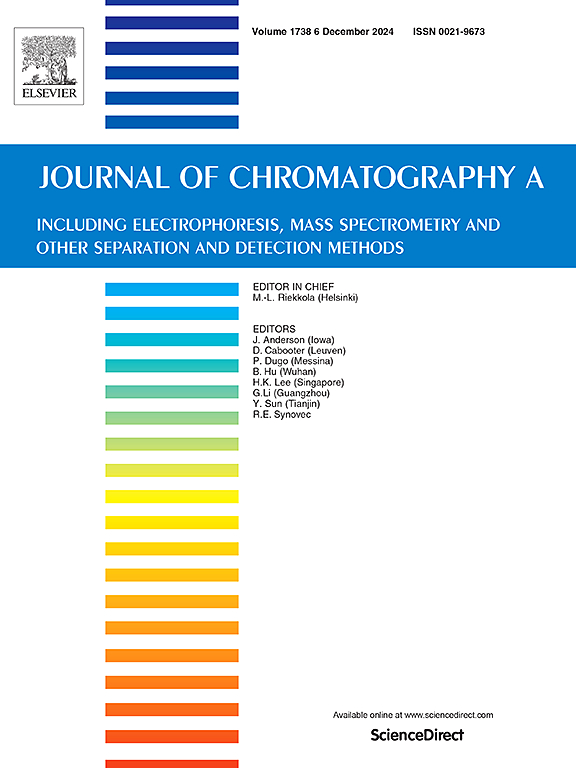在溶剂选择性指导下改进用于逆流色谱的极性溶剂系统:以正己烷/乙酸乙酯/醇类溶剂/水为例
IF 3.8
2区 化学
Q1 BIOCHEMICAL RESEARCH METHODS
引用次数: 0
摘要
在逆流色谱(CCC)分析中,根据极性选择溶剂系统是一种常见的策略。然而,溶剂系统的溶剂选择性往往被忽视,尽管它对 CCC 的分离效率有重大影响。本研究探讨了溶剂在溶剂系统整体特性中的作用以及溶剂系统的选择性分类,以改进基于极性的溶剂系统选择。首先,分析了模板分子的分配系数对数(log K)与正己烷/醋酸乙酯/醇类溶剂(甲醇、乙醇和异丙醇)/水(HEAwat)体系的溶剂组成之间的数学关系,确定了模板分子的最佳溶剂体系(K = 1)。然后,分析了高效液相色谱分析中分析物出峰时色谱柱入口处的实际甲醇浓度(B%)和最佳 CCC 溶剂系统平均极性(P')的聚类结果。最后,通过推导选择性参数方程(χe、χd 和 χn)来解释 P'值聚类结果,从而根据 HEAWat 系统的整体溶剂特性对其进行分类。结果表明,HEAWat 系统适用于分离 55% < B% < 100 % 的分析物。然而,正己烷/乙酸乙酯/异丙醇/水(HEIWat)体系比其他 HEAWat 体系更适合分离大极性化合物,因为醇类溶剂的变化导致 P'值降低。根据斯奈德方法,选定的溶剂系统被分为 III 组和 IV 组。第 III 组溶剂体系适用于 85% < B% < 100 % 的分析物分离,分析物的分布行为主要受各溶剂比例的影响。第 IV 组溶剂系统适用于 55 % < B% < 85 % 的分析物分离,分析物的分布行为主要受醇溶剂类型的影响。本文章由计算机程序翻译,如有差异,请以英文原文为准。
Improvement of polarity-based solvent system for countercurrent chromatography in the guidance of solvent selectivity: n-hexane/ethyl acetate/ alcohol solvents/water as an example
Solvent system selection based on polarity is a common strategy in a countercurrent chromatography (CCC) analysis. However, the solvent selectivity of solvent system is often ignored, despite its significant impact on the separation efficiency of CCC. In this study, the role of solvent in the overall properties of solvent system and the selective classification of solvent system were discussed to improve the solvent system selection based on polarity. Firstly, the mathematical relationship between logarithm of the partition coefficient (log K) of the template molecule and solvent composition of n-hexane/ethyl acetate/alcohol solvents (methanol, ethanol, and isopropanol)/water (HEAwat) system was analyzed and the optimal solvent system (K = 1) of the template molecules was determined. Then, the actual methanol concentration at the column inlet when the analyte peak in a HPLC analysis (B%) and the clustering results of the average polarity (P') of the optimal CCC solvent system were analyzed. Finally, the classification of HEAWat system in terms of its overall solvent properties by deducing equations of selectivity parameters (, , and ) to explain the P' values clustering results. The results showed that HEAWat system was suitable for the separation of analytes with 55 % < B% < 100 %. However, the n-hexane/ethyl acetate/isopropanol/water (HEIWat) system proved more suitable for the separation of large polar compounds to other HEAWat system when the P' value decreased due to the change of alcohol solvents. The selected solvent systems were classified into group III and IV by Snyder's method. The solvent systems in group III were suitable for the separation of analytes with 85 % < B% < 100 %, and the distribution behavior of analytes was mainly influenced by the ratio of each solvent. The solvent systems in group IV were suitable for the separation of analytes with 55 % < B% < 85 %, and the distribution behavior of analytes was mainly influenced by the type of alcohol solvents.
求助全文
通过发布文献求助,成功后即可免费获取论文全文。
去求助
来源期刊

Journal of Chromatography A
化学-分析化学
CiteScore
7.90
自引率
14.60%
发文量
742
审稿时长
45 days
期刊介绍:
The Journal of Chromatography A provides a forum for the publication of original research and critical reviews on all aspects of fundamental and applied separation science. The scope of the journal includes chromatography and related techniques, electromigration techniques (e.g. electrophoresis, electrochromatography), hyphenated and other multi-dimensional techniques, sample preparation, and detection methods such as mass spectrometry. Contributions consist mainly of research papers dealing with the theory of separation methods, instrumental developments and analytical and preparative applications of general interest.
 求助内容:
求助内容: 应助结果提醒方式:
应助结果提醒方式:


